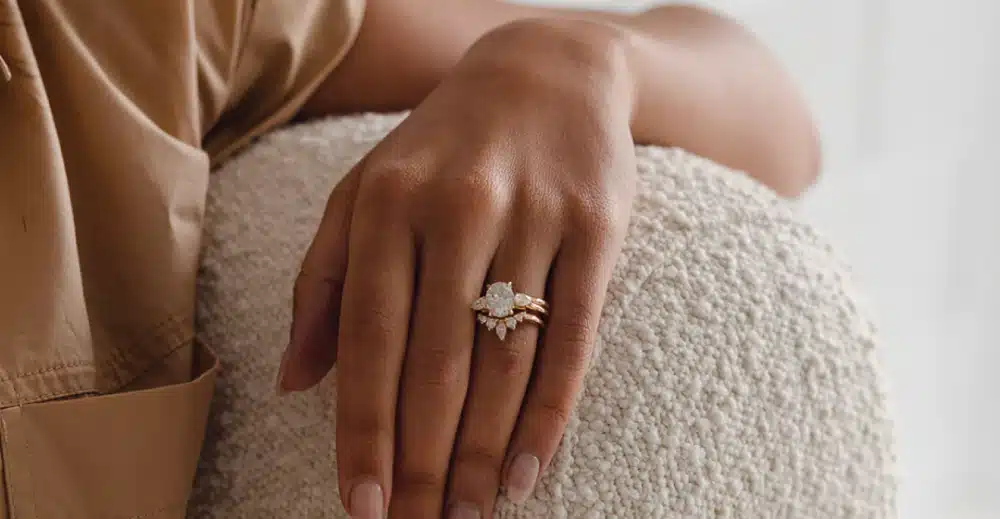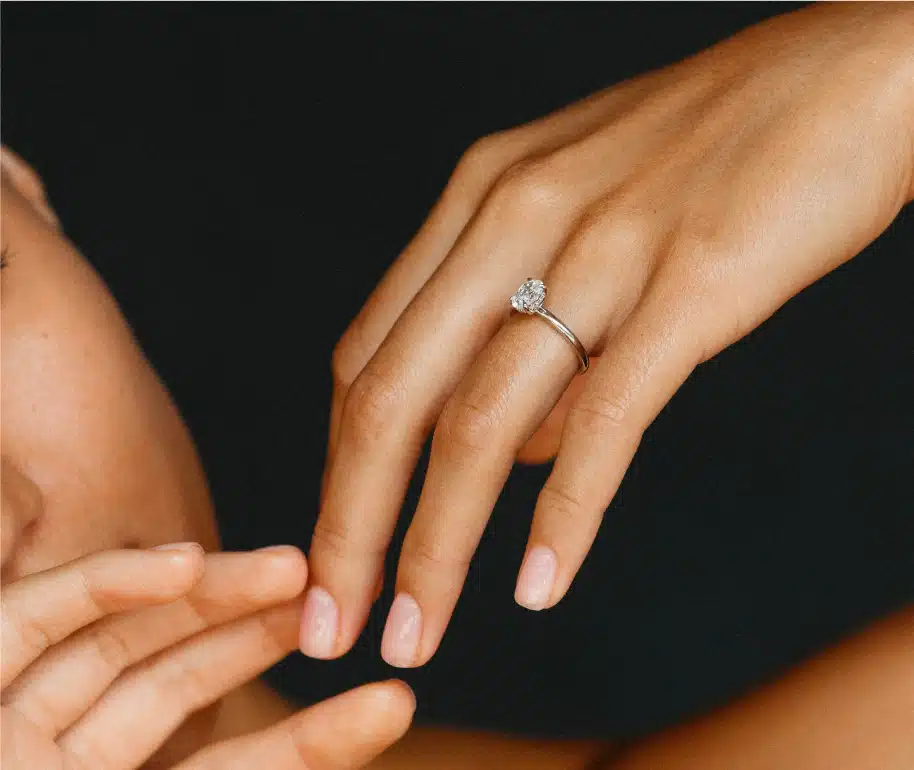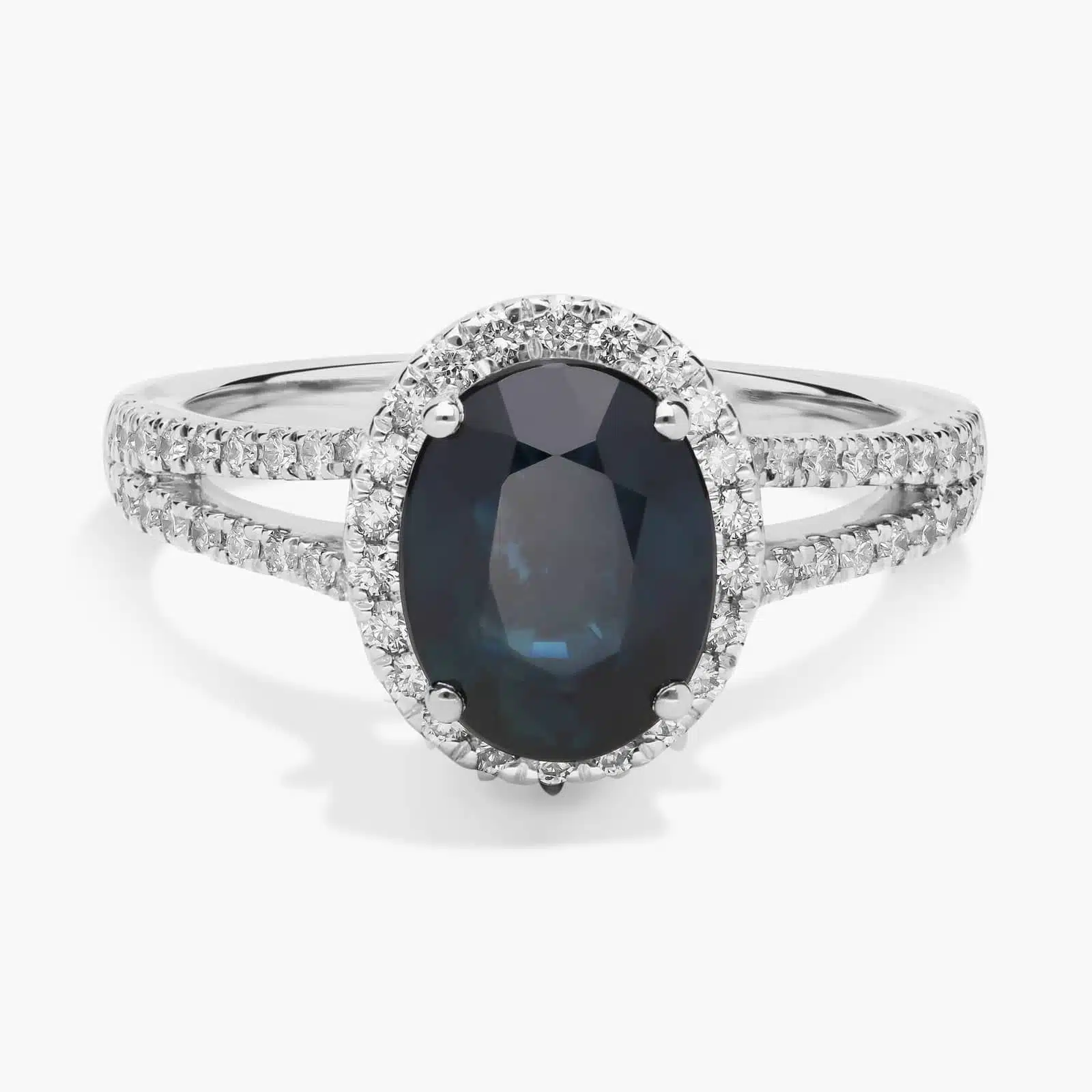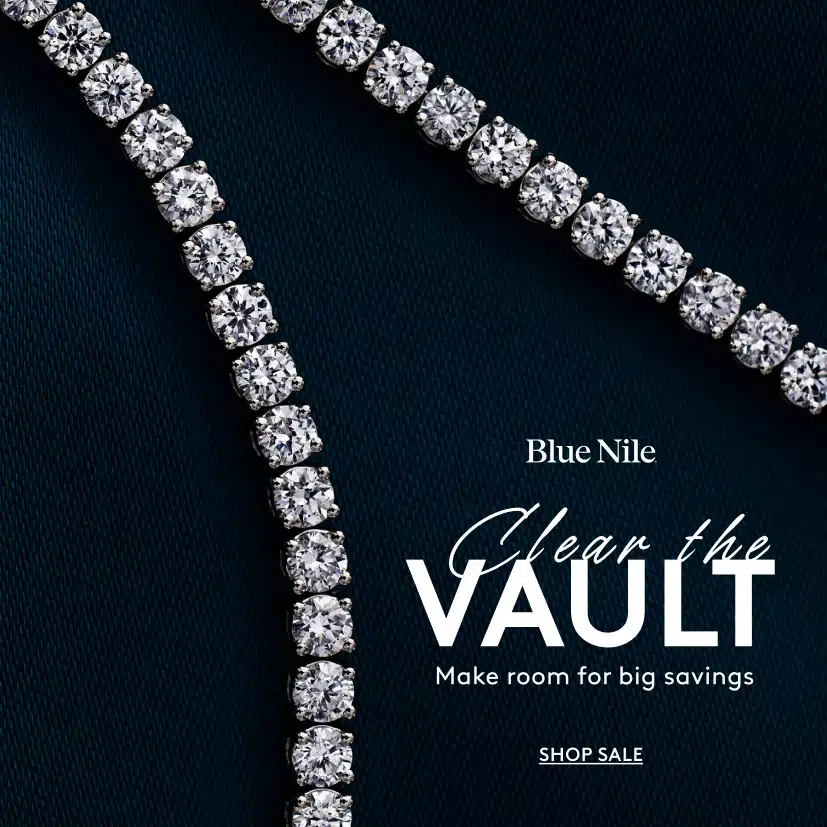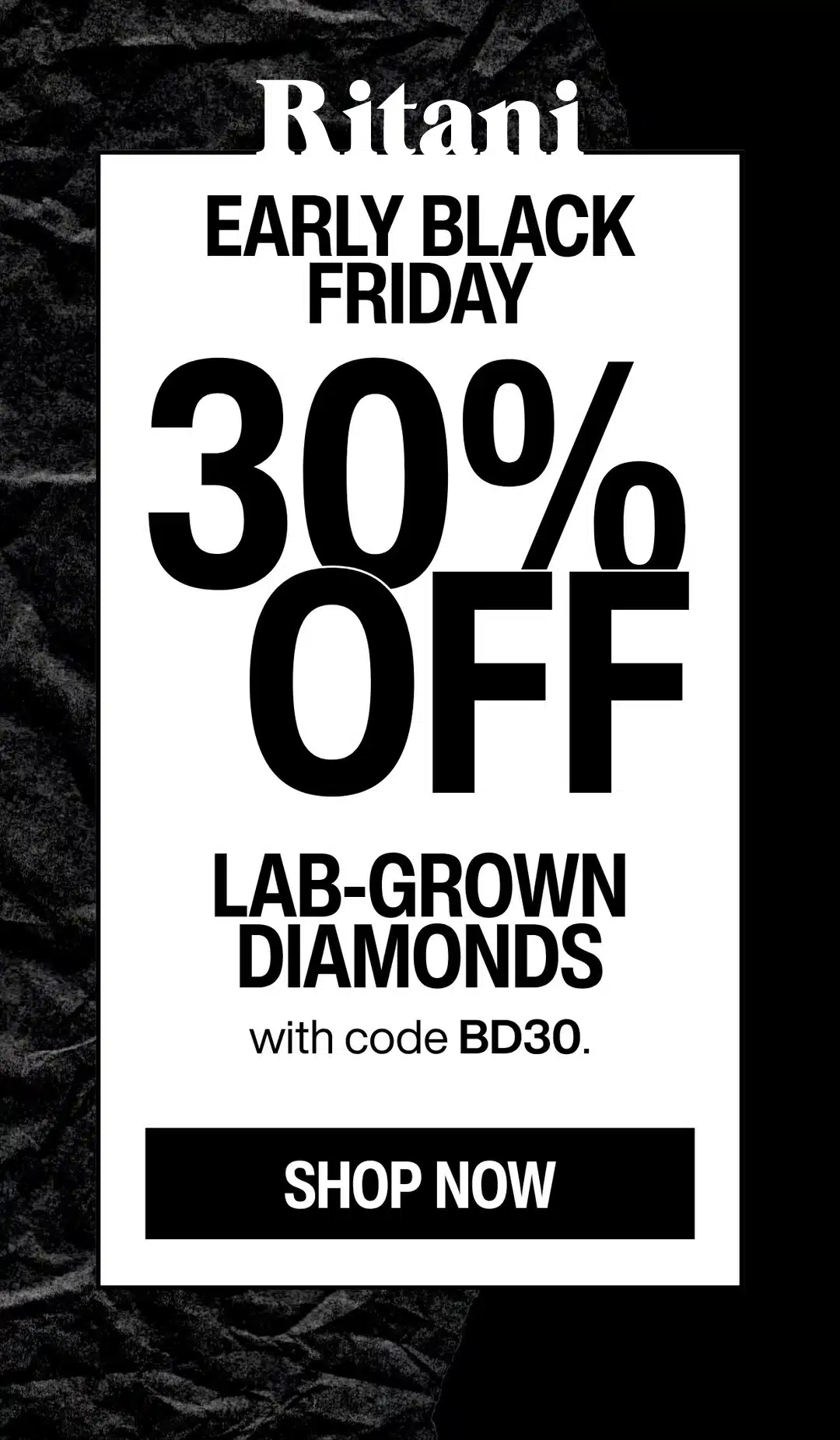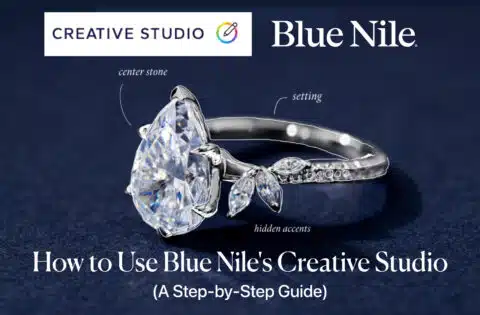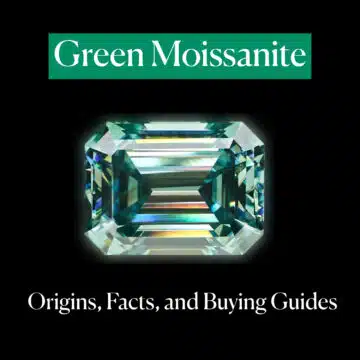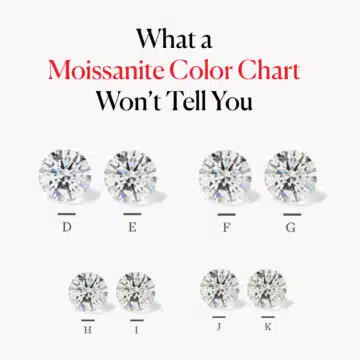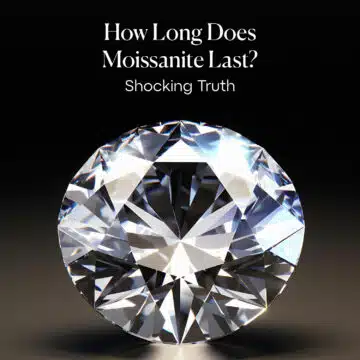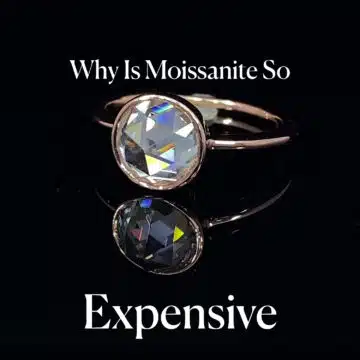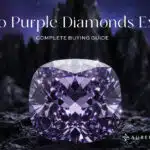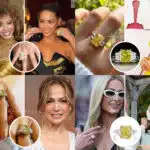Let’s settle the biggest debate in the diamond world: GIA vs. AGS. And the short answer to the question in the title is yes, you can absolutely trust the AGS grading system—in fact, for one critical reason, some experts argue you should trust it more than GIA.
In the world of diamonds, GIA and AGS are the only two names that carry undisputed authority. Think of them as Harvard and Yale. But the reason some of us in the industry get a little excited when we see an AGS report comes down to one word: Sparkle. The AGS grading system is legendary for its scientific, almost obsessive approach to analyzing how a diamond handles light.
But let’s be real. You’re probably here because you’ve found a diamond you love, saw “AGS” on the report, and felt that moment of doubt. “Is this as good as GIA? Am I losing value by choosing the less common lab? Am I about to make a mistake?”
Let me put that to rest right now: you are not making a mistake. In fact, you might be about to make a more sophisticated choice.
In this guide, I’m going to give you the ultimate breakdown. We are going to visually dissect the AGS Platinum Certificate so you know exactly what you’re reading. We’ll put the GIA and AGS scales side-by-side to see how they stack up.
And by the end, I’ll give you my unfiltered verdict on who comes out on top in the battle for the most accurate diamond grade.
Diamond IQ Test: Natural or Lab-Grown?
Two identical diamonds: GIA Certified, 1.51ct, D Color, VVS1, Ideal Cut. One is natural ($16,530), the other is lab-grown ($2,390). Choose the diamond you like better and see if you can match it to its origin.
What Am I Looking At? An In-Depth Visual Guide to the AGS Certificate
Alright, let’s pull up the document in question. At first glance, this AGS Sample certificate—specifically what they call “The Diamond Quality® Report”—can look intimidating. It’s packed with numbers, charts, and technical terms.
But trust me, once we walk through this together, you’ll see it as a transparent, data-rich story of your diamond. This report is the key to understanding the AGS grading system.
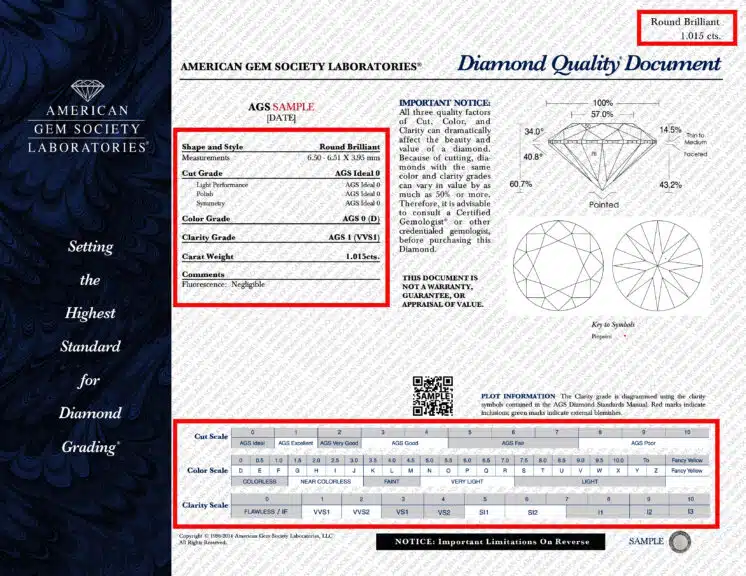
Think of this document as your diamond’s official biography, written by one of the most respected authorities in the world. It provides the proof you need to make a confident purchase. Let’s break it down, section by section, from top to bottom.
The Top Line: The Diamond’s Identity
Right at the top, you’ll see the lab’s name—American Gem Society Laboratories—and the report number. This unique number is your direct link to the report in the AGS online database, providing a crucial layer of verification.
To the right, you have the most fundamental facts, the diamond’s core DNA:
- Shape and Style: On this sample, it’s a Round Brilliant. This could also be Princess, Cushion, etc. This is the basic shape of the diamond.
- Measurements: Here it shows 6.50 – 6.51 x 3.95 mm. This is the diamond’s exact physical size—its diameter and its depth. This is a crucial piece of data for any jeweler setting the stone.
- Carat Weight: Listed as 1.015 cts. The carat is a measure of weight, not size. This tells you exactly how much your diamond weighs, down to the thousandth of a carat.
DIAMOND ON SALE!!
⏰ Tick-Tock! The Best Diamond Deals at James Allen Are Disappearing Fast!
The Core 4 Cs: Translating the AGS Grades to the Language You Know
This is the heart of the report, located on the left-hand side. It’s where the AGS diamond grading truly happens, and they do something brilliant here: they speak two languages to make it easy for you.
Cut Grade: AGS Ideal 0
This is, without a doubt, the single most important line on this entire document and the primary reason experts revere the AGS diamond certificate. Where the GIA scale stops at the broad category of “Excellent,” the AGS’s scientific system uses a numerical scale from 0 to 10.
“AGS Ideal 0” is the highest possible grade. It is the pinnacle of diamond cutting, reserved for stones with scientifically-proven, top-tier light performance. A diamond that achieves this grade is guaranteed to be a “light machine,” exploding with the fire and sparkle that makes a diamond so breathtaking.
When a diamond expert is searching for a stone with absolutely no compromises on brilliance, this is the grade they look for.
Polish & Symmetry: AGS Ideal 0
These two grades refer to the finish and craftsmanship of the diamond’s facets.
- Polish: This grades the smoothness of each facet. An “Ideal 0” means the surfaces are perfectly smooth, like flawless mirrors.
- Symmetry: This grades how perfectly shaped and aligned all the facets are. “Ideal 0” means the facets are perfectly symmetrical, allowing for maximum, uninterrupted light return.
When you have a diamond with “Ideal 0” in Cut, Polish, and Symmetry, you have what’s known as an AGS Triple Zero (or AGS 000) diamond.
This is the holy grail for cut-obsessed diamond connoisseurs. It is the absolute highest tier in the AGS diamond grading scale.
Color Grade: (H) AGS 2.0
This is where the AGS’s user-friendly approach really shines. They provide two grades in one.
- The (H) is the grade on the familiar GIA D-to-Z color scale. AGS is telling you that if GIA were to grade this diamond, it would be an “H.” This gives you a direct, trustworthy comparison point.
- The AGS 2.0 is their own, more granular numerical grade from their 0-10 scale. A 0.0 is a perfect “D,” and the numbers increase from there.
Why this matters to you: You can be 100% confident that an “H” color from AGS is the exact same as an “H” color from GIA. They are calibrated to the same master stones.
Clarity Grade: (SI1) AGS 5
AGS uses the exact same system for clarity.
- The (SI1) is the grade from the GIA’s scale, which ranges from Flawless down to Included.
- The AGS 5 is their corresponding numerical grade.
Why this matters to you: Just like with color, you can have complete confidence that an “SI1” from AGS is the same as an “SI1” from GIA. On these two crucial value factors, the labs are in perfect agreement. The anxiety of wondering “Is my AGS SI1 really an SI1?” is completely unfounded.
The Plot Diagram & Comments: A Map of Your Diamond’s Soul
This section provides transparency into your diamond’s unique identity.
The Plot Diagram
The two large circles in the middle of the report are clarity plots. They are a top-down and bottom-up map of your diamond’s “birthmarks.” The Key to Symbols tells you what the little red marks on the diagram mean.
For example, a “Feather” is a tiny fracture, a “Crystal” is a microscopic mineral crystal trapped inside, and a “Pinpoint” is a tiny dot.
Why this matters to you: This plot is your proof of an “eye-clean” diamond. For an SI1 grade like this, you want to see that the inclusions are small, off to the side, and not a large, dark crystal right in the middle of the table. It is, essentially, a treasure map of your diamond’s clarity characteristics.
Comments
This section lists any additional facts about the diamond. The most common comment, as seen on the sample, is about fluorescence (Fluorescence: Negligible).
This is a technical detail, but important to note. The other common comment mentions any inscriptions on the diamond’s girdle (the thin edge), such as the report number.
By understanding how to read this document, you’re not just buying a diamond; you’re buying a verifiable, scientifically-proven piece of art, and the AGS certification gives you the complete story.
Best Deal Of The Year – Final Days
Blue Nile’s “Clear The Vault” is ON.
Shop Fine Jewelry Upto 70% OFF.
*Exclusions may apply. See Blue Nile for complete details.
The AGS Secret Weapon: Decoding the Light Performance ASET Map
Alright, now we get to it. This is the single biggest differentiator between the two labs and the primary reason many diamond experts, myself included, have so much respect for the AGS grading system.
If you’re buying a diamond with their top-tier “Platinum” report, you’ll get a second document: “The Platinum Light Performance Diamond Quality® Document.”
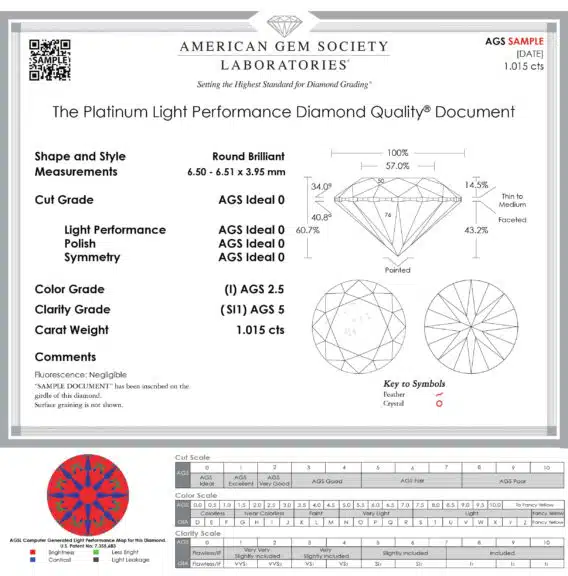
Your eye is immediately drawn to that colorful circle at the bottom, and it’s exactly where it should be. This little colored map is the ASET, which stands for “Angular Spectrum Evaluation Tool.” And honestly? This map is the entire ballgame.
While a GIA report is a brilliant resume of a diamond’s qualities, the AGS Light Performance report with its ASET map is a scientific, data-driven performance review. It doesn’t just describe the diamond; it shows you, with objective, visual proof, exactly how that diamond handles light.
Let’s demystify what those colors mean. They’re actually a map showing you where the diamond is gathering its light from. It’s far simpler than it looks.
The ASET Colors Explained: A Heat Map of Your Diamond’s Sparkle
Think of this ASET map as a “heat map” of your diamond’s brilliance. The different colors show the intensity of the light returning to your eye. The more “hot” colors (red) you see, the more fire and life the diamond will have.
Red is Your Best Friend
What it means: Red represents the most powerful, direct, and intense light that is being returned to your eye. This is the light that is coming from the richest source, high overhead.
My Take (Why it matters to you): Think of RED as ‘Robust Light Return.’ This is the direct source of a diamond’s brilliant, fiery sparkle. In an ideally cut diamond, the ASET map should be overwhelmingly dominated by red.
It is the visual proof that the diamond’s facets are perfectly angled to capture and return the most powerful light, giving you that breathtaking, “across the room” sparkle you’re paying for. More red means more bang for your buck.
Green is Good Secondary Light
What it means: Green represents light that is being gathered from lower, more indirect angles—reflecting off walls, the table, or the surrounding environment.
My Take (Why it matters to you): While not as powerful as red light, this green light is crucial for a diamond’s overall brightness. It fills in the spaces, ensuring the diamond looks bright and alive even in lighting conditions that aren’t perfect, like in a softly lit restaurant. A good ASET map will have a healthy amount of green, primarily visible under the main table facet.
Blue is for Contrast
What it means: The blue pattern represents the areas of the diamond that are reflecting the viewer’s head and body, creating a shadow or contrast. This might sound bad, but it’s absolutely essential for sparkle.
My Take (Why it matters to you): The blue arrows and patterns are the secret ingredient to a diamond’s “scintillation”—that dramatic, flashing effect you see as the diamond moves. The human eye needs contrast to perceive sparkle.
A diamond with no blue would look bright but flat. A perfectly cut diamond will have a crisp, sharp, and symmetrical blue pattern, creating a beautiful “on/off” blinking effect with every tiny movement.
Read Our 5-Star Blue Nile Review
Check our comprehensive Blue Nile review to learn why we rated Blue Nile 5 stars for their exceptional quality and value.
What You Don’t Want to See: Light Leakage
There’s one more color that sometimes appears: white or black (depending on the ASET software). This represents “light leakage”—areas where light is entering the diamond and immediately escaping out the bottom or sides instead of returning to your eye. It’s the sign of a poor cut. An AGS Ideal 0 cut diamond will have virtually no light leakage.
The Mehedi Verdict: Why This Matters More Than Words
Here’s the bottom line. A standard GIA report tells you a diamond’s cut is “Excellent” based on its proportions. The AGS ASET map shows you, with irrefutable scientific proof, exactly how and how well it performs.
It’s the difference between a resume and a live performance review. This little colored map is the ultimate peace of mind for a buyer who wants to be absolutely certain they are getting a top-tier, fiery diamond, and it’s the single greatest argument for why the AGS grading system is so trusted by experts.
The Head-to-Head: GIA vs. AGS Grading Scales
So, we know the AGS report has the powerful ASET map. But how do the basic grades really stack up against the GIA, the global industry standard?
This is where people get nervous. Is an AGS “Ideal” really the same as a GIA “Excellent”? Is an AGS “2.5” color the same as a GIA “I” color?
Let’s stop guessing and look at the evidence. The charts below, created using data from both labs, show a direct, one-to-one comparison.
The Cut Grade Showdown
This is where the biggest difference—and the most confusion—lies. But it’s actually quite simple.

As you can see, the main difference isn’t in the standard, but in the granularity.
The GIA’s highest tier is the broad category of “Excellent.” It’s a fantastic grade, but a lot of diamonds fit into it.
The AGS grading system takes that same top-tier group and breaks it down even further. An AGS Ideal (0) and an AGS Excellent (1) both fall within the GIA “Excellent” category. AGS is simply providing an extra level of detail at the very top of the pyramid.
An AGS 0 is the best of the best of GIA’s “Excellent” group. Think of GIA “Excellent” as an “A+” grade in a class. AGS then goes a step further and tells you which students scored a 98%, a 99%, and a perfect 100%.
The Color & Clarity Verdict: A Perfect Match
This is where I can give you the most reassuring news possible. When it comes to color and clarity—the two factors that most heavily influence a diamond’s price—the two labs are in lockstep.
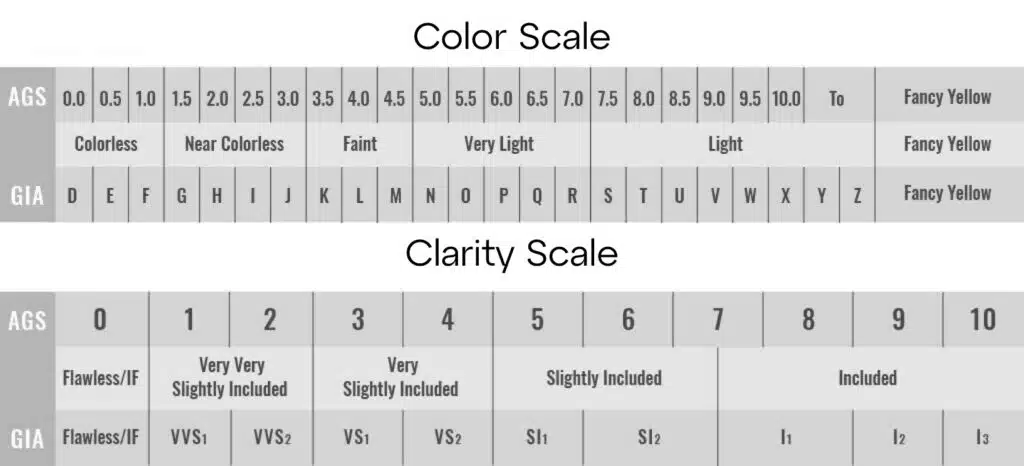
Look at these charts. It’s a direct, one-to-one correlation.
An AGS 2.0 Color Grade lines up perfectly with a GIA H Color Grade. An AGS 5.0 Clarity Grade is the exact equivalent of a GIA SI1 Clarity Grade. There is no ambiguity. Both labs built their grading systems on the same master stones and the same core principles.
My Take (The only one you need): On these crucial value factors, you can trust them equally and without hesitation. The anxiety that an AGS-graded diamond might be over-graded for color or clarity is completely unfounded.
An “H” is an “H,” and a “VS2” is a “VS2,” no matter which of these two elite labs signs the report. This is a critical fact that gives you the confidence to shop for an AGS certified diamond knowing you’re getting a fair and accurate assessment.
Why a Diamond’s Cut is Everything
So why are we, and especially the AGS, so obsessed with a diamond’s cut grade? Why does it matter more than the other Cs?
It’s because a diamond doesn’t create light; it only reflects it. A diamond’s sparkle is just a game of mirrors. The quality of the cut determines how well that game is played. This simple image explains it all.

Think of a diamond as a complex system of mirrors. Its job is to capture the light that enters through the top, bounce it around the internal facets, and shoot it straight back out to your eye as a brilliant, fiery explosion.
Ideal Cut: The Perfect Light Machine
In a well-cut diamond, the angles of the facets are mathematically perfect. As you can see in the “Ideal” diagram, light enters the top (the table), travels down to the bottom facets (the pavilion), and reflects perfectly back up and out through the top. This is what creates that dazzling brilliance and fire. Every facet is doing its job perfectly, returning the maximum amount of light to you.
Shallow Cut: The “Fish-Eye” Dud
Now look at the “Shallow” diagram. When a diamond’s cut is too shallow, it fails at its one job. Light enters the top, but because the pavilion angles are too flat, the light doesn’t bounce back up. Instead, it “leaks” straight out the bottom of the diamond where no one can see it.
This is what we call a “fish-eye” or a “nail head” diamond—it looks glassy, dead in the center, and has almost no sparkle. It’s a tragedy.
Deep Cut: Paying for Weight You Can’t See
The “Deep” cut is just as bad, but for a different reason. As you can see, when the cut is too deep, the light enters and hits the pavilion at such a steep angle that it’s deflected out the side of the diamond, not the top. All that potential sparkle is lost, lighting up the side of the ring setting instead of returning to your eye.
What’s worse is that a deep-cut diamond is a terrible value. A significant portion of its carat weight is hidden in its depth. So, a deep-cut 1.00-carat diamond might have the same face-up diameter as a well-cut 0.90-carat diamond. You are literally paying for weight you can’t see and getting less sparkle in return.
The AGS Insurance Policy
This, right here, is what the entire AGS grading system for cut is designed to protect you from. A diamond might have a D color and a Flawless clarity, but if it’s cut poorly like the “Shallow” or “Deep” examples, it will look lifeless and be a terrible waste of money.
The AGS Light Performance Report, and especially its ASET map, is your insurance policy. It provides scientific, visual proof that your diamond is an “Ideal” light machine, not a shallow or deep dud. It guarantees you’re getting the breathtaking sparkle you’re paying for.
James Allen: Our 5-Star Choice for Price and Selection
Check our comprehensive James Allen Review to learn more about their pricing and commitment.
The Final Verdict & Your Questions Answered
So, after all the analysis, reports, and ASET maps, we come back to the original question: should you trust the AGS grading system over GIA?
My answer is this: You can absolutely trust it equally, and if you are a buyer who prioritizes guaranteed sparkle and scientific proof, you can and should trust it more.
GIA is the global standard, the industry’s bedrock. It is a fantastic, reliable institution. But the AGS grading system is the connoisseur’s choice specifically for cut analysis. It provides an unparalleled level of detail and objective, scientific data about a diamond’s brilliance and fire.
Buying a top-graded AGS Ideal 000 diamond is one of the safest and smartest ways to guarantee you are getting a truly breathtaking, top-tier stone. You can shop for one with absolute confidence.
Frequently Asked Questions
When it comes to the AGS vs. GIA debate, a few questions always pop up. Here are my direct answers to the most common ones.


